Energy Storage Science and Technology ›› 2023, Vol. 12 ›› Issue (7): 2105-2118.doi: 10.19799/j.cnki.2095-4239.2023.0253
Previous Articles Next Articles
Jiayi ZHANG1,2( ), Suting WENG1,3, Zhaoxiang WANG1,2,3, Xuefeng WANG1,2,3,4(
), Suting WENG1,3, Zhaoxiang WANG1,2,3, Xuefeng WANG1,2,3,4( )
)
Received:2023-04-25
Revised:2023-06-12
Online:2023-07-05
Published:2023-07-25
Contact:
Xuefeng WANG
E-mail:1114624518@qq.com;wxf@iphy.ac.cn
CLC Number:
Jiayi ZHANG, Suting WENG, Zhaoxiang WANG, Xuefeng WANG. Solid electrolyte interphase (SEI) on graphite anode correlated with thermal runaway of lithium-ion batteries[J]. Energy Storage Science and Technology, 2023, 12(7): 2105-2118.
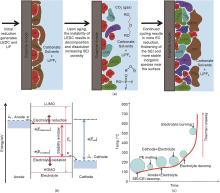
Fig. 1
(a) Schematic of SEI formation on graphite anode[22]; (b) Thermodynamics of SEI formation on anode and cathode, where μe-,Anode and μe-,Cathode are the electrochemical potentials of the anode and cathode respectively, and the stability window of the electrolyte is the difference between the energies of LUMO and HOMO, expressed as Eg[30]; (c) Qualitative description of chain reactions during thermal runaway[5]"


Fig. 2
(a) Schematic of in-situ heating XPS; (b) Quantitative analysis of the XPS survey spectra, C 1s, O 1s, and F 1s spectra from the lithiated VGCF during the temperature rising from 25 ℃ to 300 ℃; (c) Cryo-TEM images of SEI on the lithiated VGCF at 25, 150, 200 ℃ and their corresponding elemental distribution of C (marked in red) and O (marked in green) based on EELS map scanning[34]"

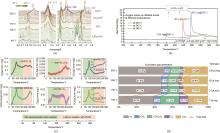
Fig. 3
(a) In-situ XRD patterns of the lithiated graphite anode when heated from 25 to 280 ℃ at 2 ℃/min; (b) The influence of oxygen on the lithiated graphite anode at different temperatures during the DSC measurements; (c) In-situ monitoring the evolution of H2, CH3·, CH4, CO/C2H4, O2, and CO2 during heating of the lithiated graphite anode; (d) The quantitative analysis of the gas cumulative ratio at 100, 150, 200, and 250 ℃, respectively[39]"

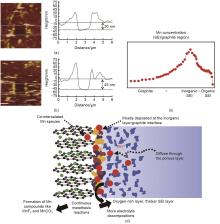
Fig. 5
AFM height images and their corresponding averaged cross-section of HOPG cycled in (a) Mn-free electrolyte and (b) Mn-containing electrolyte; (c) Mn distribution along the cross-sectional electrode when it was stored for one month after 5 cycles in Mn-containing electrolyte; (d) Schematic diagram of the effect of Mn2+ deposition on graphite anode[54]"

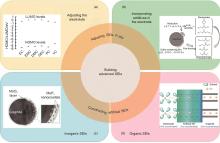
Fig. 6
Summary of SEI regulation strategies (a) regulating the composition of the electrolyte, such as adjusting the HOMO-LUMO of solvents[5]; (b) Incorporating additives into the anode facilitating the in-situ construction of SEI with high Li+ conductivity, such as sulfur element[57]; (c) Inorganic coating layer, such as MoO x -MoP x coated graphite[58]; (d) Organic coating layer, such as the polymer SEI that promotes the transport of Li+ between electrolyte and graphite anode[4, 59]"

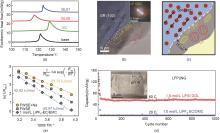
Fig. 7
(a) DSC curves of the fully de-lithiated graphite anodes collected from the cells cycled in 1 mol/L LiPF6 EC/EMC (volume ratio 1∶2) electrolytes with/without mass fraction 2% VC/glycolide (GL00)/GL01 additives[61]; (b) High-resolution cryo-TEM image of the SEI formed in 1.8 mol/L LiFSI DOL electrolyte, and the inset shows the corresponding FFT pattern; (c) Corresponding schematic of the high-resolution cryo-TEM image; (d) Long cycling performance of LiFePO4||graphite pouch cells with two electrolytes, and the inset shows a photograph of the pouch cell[66]; (e) Diffusion activation energy of Li+ in SEI[67]"

| 1 | WANG Q S, MAO B B, STOLIAROV S I, et al. A review of lithium ion battery failure mechanisms and fire prevention strategies[J]. Progress in Energy and Combustion Science, 2019, 73: 95-131. |
| 2 | MELIN H E, RAJAEIFAR M A, KU A Y, et al. Global implications of the EU battery regulation[J]. Science, 2021, 373(6553): 384-387. |
| 3 | ALI RAJAEIFAR M, GHADIMI P, RAUGEI M, et al. Challenges and recent developments in supply and value chains of electric vehicle batteries: A sustainability perspective[J]. Resources, Conservation and Recycling, 2022, 180: 106144. |
| 4 | CAI W L, YAO Y X, ZHU G L, et al. A review on energy chemistry of fast-charging anodes[J]. Chemical Society Reviews, 2020, 49(12): 3806-3833. |
| 5 | ZU C X, YU H G, LI H. Enabling the thermal stability of solid electrolyte interphase in Li-ion battery[J]. InfoMat, 2021, 3(6): 48-661. |
| 6 | LI W F, WANG H W, OUYANG M G, et al. Theoretical and experimental analysis of the lithium-ion battery thermal runaway process based on the internal combustion engine combustion theory[J]. Energy Conversion and Management, 2019, 185: 211-222. |
| 7 | LOVERIDGE M, REMY G, KOURRA N, et al. Looking deeper into the galaxy (note 7)[J]. Batteries, 2018, 4(1): 3. |
| 8 | JIANG X M, CHEN Y J, MENG X K, et al. The impact of electrode with carbon materials on safety performance of lithium-ion batteries: A review[J]. Carbon, 2022, 191: 448-470. |
| 9 | LEI B X, ZHAO W J, ZIEBERT C, et al. Experimental analysis of thermal runaway in 18650 cylindrical Li-ion cells using an accelerating rate calorimeter[J]. Batteries, 2017, 3(4): 14. |
| 10 | WANG M, NOELLE D J, SHI Y, et al. Effect of Notch depth of modified current collector on internal-short-circuit mitigation for lithium-ion battery[J]. Journal of Physics D: Applied Physics, 2018, 51(1): 015502. |
| 11 | WANG Q S, PING P, ZHAO X J, et al. Thermal runaway caused fire and explosion of lithium ion battery[J]. Journal of Power Sources, 2012, 208: 210-224. |
| 12 | FENG X N, OUYANG M G, LIU X, et al. Thermal runaway mechanism of lithium ion battery for electric vehicles: A review[J]. Energy Storage Materials, 2018, 10: 246-267. |
| 13 | LI Y Q, LU Y X, ADELHELM P, et al. Intercalation chemistry of graphite: Alkali metal ions and beyond[J]. Chemical Society Reviews, 2019, 48(17): 4655-4687. |
| 14 | ETACHERI V, MAROM R, ELAZARI R, et al. Challenges in the development of advanced Li-ion batteries: A review[J]. Energy & Environmental Science, 2011, 4(9): 3243-3262. |
| 15 | AURBACH D, MARKOVSKY B, SHECHTER A, et al. A comparative study of synthetic graphite and Li electrodes in electrolyte solutions based on ethylene carbonate-dimethyl carbonate mixtures[J]. Journal of the Electrochemical Society, 1996, 143(12): 3809-3820. |
| 16 | VERMA P, MAIRE P, NOVÁK P. A review of the features and analyses of the solid electrolyte interphase in Li-ion batteries[J]. Electrochimica Acta, 2010, 55(22): 6332-6341. |
| 17 | PELED E, MENKIN S. Review—SEI: Past, present and future[J]. Journal of the Electrochemical Society, 2017, 164(7): A1703-A1719. |
| 18 | XU K. Electrolytes and interphases in Li-ion batteries and beyond[J]. Chemical Reviews, 2014, 114(23): 11503-11618. |
| 19 | AN S J, LI J L, DANIEL C, et al. The state of understanding of the lithium-ion-battery graphite solid electrolyte interphase (SEI) and its relationship to formation cycling[J]. Carbon, 2016, 105: 52-76. |
| 20 | YUAN S Y, WENG S T, WANG F, et al. Revisiting the designing criteria of advanced solid electrolyte interphase on lithium metal anode under practical condition[J]. Nano Energy, 2021, 83: doi: 10. 1016/j. nanoen. 2021. 105847. |
| 21 | ZHU C N, SUN C C, LI R H, et al. Anion-diluent pairing for stable high-energy Li metal batteries[J]. ACS Energy Letters, 2022, 7(4): 1338-1347. |
| 22 | HEISKANEN S K, KIM J, LUCHT B L. Generation and evolution of the solid electrolyte interphase of lithium-ion batteries[J]. Joule, 2019, 3(10): 2322-2333. |
| 23 | NIE M Y, CHALASANI D, ABRAHAM D P, et al. Lithium ion battery graphite solid electrolyte interphase revealed by microscopy and spectroscopy[J]. The Journal of Physical Chemistry C, 2013, 117(3): 1257-1267. |
| 24 | LIU T C, LIN L P, BI X X, et al. In situ quantification of interphasial chemistry in Li-ion battery[J]. Nature Nanotechnology, 2019, 14(1): 50-56. |
| 25 | YOON T, MILIEN M S, PARIMALAM B S, et al. Thermal decomposition of the solid electrolyte interphase (SEI) on silicon electrodes for lithium ion batteries[J]. Chemistry of Materials, 2017, 29(7): 3237-3245. |
| 26 | ZENG X J, LIU D Q, WANG S W, et al. In situ observation of interface evolution on a graphite anode by scanning electrochemical microscopy[J]. ACS Applied Materials & Interfaces, 2020, 12(33): 37047-37053. |
| 27 | SHI S Q, LU P, LIU Z Y, et al. Direct calculation of Li-ion transport in the solid electrolyte interphase[J]. Journal of the American Chemical Society, 2012, 134(37): 15476-15487. |
| 28 | BENITEZ L, SEMINARIO J M. Ion diffusivity through the solid electrolyte interphase in lithium-ion batteries[J]. Journal of the Electrochemical Society, 2017, 164(11): E3159-E3170. |
| 29 | RAMASUBRAMANIAN A, YURKIV V, FOROOZAN T, et al. Lithium diffusion mechanism through solid-electrolyte interphase in rechargeable lithium batteries[J]. The Journal of Physical Chemistry C, 2019, 123(16): 10237-10245. |
| 30 | PELJO P, GIRAULT H H. Electrochemical potential window of battery electrolytes: The HOMO-LUMO misconception[J]. Energy & Environmental Science, 2018, 11(9): 2306-2309. |
| 31 | GOODENOUGH J B, KIM Y. Challenges for rechargeable Li batteries[J]. Chemistry of Materials, 2010, 22(3): 587-603. |
| 32 | 张慧敏, 王京, 王一博, 等. 锂离子电池SEI多尺度建模研究展望[J]. 储能科学与技术, 2023, 12(2): 366-382. |
| ZHANG H M, WANG J, WANG Y B, et al. Multiscale modeling of the SEI of lithium-ion batteries[J]. Energy Storage Science and Technology, 2023, 12(2): 366-382. | |
| 33 | FENG X N, ZHENG S Q, REN D S, et al. Investigating the thermal runaway mechanisms of lithium-ion batteries based on thermal analysis database[J]. Applied Energy, 2019, 246: 53-64. |
| 34 | WU J P, WENG S T, ZHANG X A, et al. In situ detecting thermal stability of solid electrolyte interphase (SEI)[J]. Small, 2023, 19(25): e2208239. |
| 35 | HUANG S Q, CHEONG L Z, WANG D Y, et al. Thermal stability of solid electrolyte interphase of lithium-ion batteries[J]. Applied Surface Science, 2018, 454: 61-67. |
| 36 | LIU K, LIU Y Y, LIN D C, et al. Materials for lithium-ion battery safety[J]. Science Advances, 2018, 4(6): eaas9820. |
| 37 | PARIMALAM B S, MACINTOSH A D, KADAM R, et al. Decomposition reactions of anode solid electrolyte interphase (SEI) components with LiPF6[J]. The Journal of Physical Chemistry C, 2017, 121(41): 22733-22738. |
| 38 | SEO D M, CHALASANI D, PARIMALAM B S, et al. Reduction reactions of carbonate solvents for lithium ion batteries[J]. ECS Electrochemistry Letters, 2014, 3(9): A91-A93. |
| 39 | LIU X, YIN L, REN D S, et al. In situ observation of thermal-driven degradation and safety concerns of lithiated graphite anode[J]. Nature Communications, 2021, 12: 4235. |
| 40 | JIN Y, ZHENG Z K, WEI D H, et al. Detection of micro-scale Li dendrite via H2 gas capture for early safety warning[J]. Joule, 2020, 4(8): 1714-1729. |
| 41 | TRIPATHI A M, SU W N, HWANG B J. In situ analytical techniques for battery interface analysis[J]. Chemical Society Reviews, 2018, 47(3): 736-851. |
| 42 | KRISTON A, ADANOUJ I, RUIZ V, et al. Quantification and simulation of thermal decomposition reactions of Li-ion battery materials by simultaneous thermal analysis coupled with gas analysis[J]. Journal of Power Sources, 2019, 435(30): 226774. |
| 43 | XU K, ZHUANG G V, ALLEN J L, et al. Syntheses and characterization of lithium alkyl mono-and dicarbonates as components of surface films in Li-ion batteries[J]. The Journal of Physical Chemistry B, 2006, 110(15): 7708-7719. |
| 44 | 杲齐新, 赵景腾, 李国兴. 锂离子电池快速充电研究进展[J/OL]. 储能科学与技术: 1-18[2023-06-27]. https://doi.org/10.19799/j.cnki. 2095-4239.2023-0287. |
| GAO Q, ZHAO J, LI G. Research progress of fast-chaiging lithium-ion batteries[J/OL]. Energy Storage Science and Technology: 1-18[2023-06-27]. https: //doi.org/10.19799/j.cnki.2095-4239.2023-0287. | |
| 45 | ZHAO X C, YIN Y L, HU Y, et al. Electrochemical-thermal modeling of lithium plating/stripping of Li(Ni0.6Mn0.2Co0.2)O2/carbon lithium-ion batteries at subzero ambient temperatures[J]. Journal of Power Sources, 2019, 418: 61-73. |
| 46 | BIRKENMAIER C, BITZER B, HARZHEIM M, et al. Lithium plating on graphite negative electrodes: Innovative qualitative and quantitative investigation methods[J]. Journal of the Electrochemical Society, 2015, 162(14): A2646-A2650. |
| 47 | WALDMANN T, HOGG B I, WOHLFAHRT-MEHRENS M. Li plating as unwanted side reaction in commercial Li-ion cells-A review[J]. Journal of Power Sources, 2018, 384: 107-124. |
| 48 | YANG G J, ZHANG S M, WENG S T, et al. Anionic effect on enhancing the stability of a solid electrolyte interphase film for lithium deposition on graphite[J]. Nano Letters, 2021, 21(12): 5316-5323. |
| 49 | LIN D C, LIU Y Y, CUI Y. Reviving the lithium metal anode for high-energy batteries[J]. Nature Nanotechnology, 2017, 12(3): 194-206. |
| 50 | HAO F, VERMA A, MUKHERJEE P P. Mechanistic insight into dendrite-SEI interactions for lithium metal electrodes[J]. Journal of Materials Chemistry A, 2018, 6(40): 19664-19671. |
| 51 | YAN C, ZHANG Q A. Towards the intercalation and lithium plating mechanism for high safety and fast-charging lithium-ion batteries: A review[J]. Energy Lab, 2022, 1: 220011. |
| 52 | LI W X, JIE Y L, CHEN Y H, et al. Crossover effects of transition metal ions in high-voltage lithium metal batteries[J]. Nano Research, 2022: 1-8. |
| 53 | ABRAHAM D P, SPILA T, FURCZON M M, et al. Evidence of transition-metal accumulation on aged graphite anodes by SIMS[J]. Electrochemical and Solid-State Letters, 2008, 11(12): A226. |
| 54 | SHIN H, PARK J, SASTRY A M, et al. Degradation of the solid electrolyte interphase induced by the deposition of manganese ions[J]. Journal of Power Sources, 2015, 284: 416-427. |
| 55 | LI W D, KIM U H, DOLOCAN A, et al. Formation and inhibition of metallic lithium microstructures in lithium batteries driven by chemical crossover[J]. ACS Nano, 2017, 11(6): 5853-5863. |
| 56 | XIE Q M, CHEN J W, XING L D, et al. Revealing the critical effect of solid electrolyte interphase on the deposition and detriment of Co(Ⅱ) ions to graphite anode[J]. Journal of Energy Chemistry, 2022, 69: 389-396. |
| 57 | JURNG S, KIM H S, LEE J G, et al. Low-temperature characteristics and film-forming mechanism of elemental sulfur additive on graphite negative electrode[J]. Journal of the Electrochemical Society, 2015, 163(2): A223-A228. |
| 58 | LEE S M, KIM J, MOON J, et al. A cooperative biphasic MoOx-MoPx promoter enables a fast-charging lithium-ion battery[J]. Nature Communications, 2021, 12: 39. |
| 59 | LI F S, WU Y S, CHOU J, et al. A mechanically robust and highly ion-conductive polymer-blend coating for high-power and long-life lithium-ion battery anodes[J]. Advanced Materials, 2015, 27(1): 130-137. |
| 60 | OTA H, SAKATA Y, INOUE A, et al. Analysis of vinylene carbonate derived SEI layers on graphite anode[J]. Journal of the Electrochemical Society, 2004, 151(10): A1659. |
| 61 | JEON J, YOON S, PARK T, et al. Tuning glycolide as an SEI-forming additive for thermally robust Li-ion batteries[J]. Journal of Materials Chemistry, 2012, 22(39): 21003-21008. |
| 62 | ESHETU G G, GRUGEON S, GACHOT G, et al. LiFSI vs. LiPF6 electrolytes in contact with lithiated graphite: Comparing thermal stabilities and identification of specific SEI-reinforcing additives[J]. Electrochimica Acta, 2013, 102: 133-141. |
| 63 | TAN J A, MATZ J, DONG P, et al. A growing appreciation for the role of LiF in the solid electrolyte interphase[J]. Advanced Energy Materials, 2021, 11(16): 2100046. |
| 64 | JIANG H, LIU J E, WANG M M, et al. Stable rooted solid electrolyte interphase for lithium-ion batteries[J]. The Journal of Physical Chemistry Letters, 2021, 12(43): 10521-10531. |
| 65 | HE M F, GUO R, HOBOLD G M, et al. The intrinsic behavior of lithium fluoride in solid electrolyte interphases on lithium[J]. Proceedings of the National Academy of Sciences of the United States of America, 2020, 117(1): 73-79. |
| 66 | SUN C C, JI X, WENG S T, et al. 50C fast-charge Li-ion batteries using a graphite anode[J]. Advanced Materials, 2022, 34(43): e2206020. |
| 67 | ZHENG X Y, CAO Z, LUO W, et al. Solvation and interfacial engineering enable -40 ℃ operation of graphite/NCM batteries at energy density over 270 Wh/kg[J]. Advanced Materials, 2023, 35(10): e2210115. |
| 68 | QI W B, BEN L B, YU H L, et al. Improving the electrochemical cycling performance of anode materials via facile in situ surface deposition of a solid electrolyte layer[J]. Journal of Power Sources, 2019, 424: 150-157. |
| 69 | BHATTACHARYA S, RIAHI A R, ALPAS A T. Electrochemical cycling behaviour of lithium carbonate (Li2CO3) pre-treated graphite anodes-SEI formation and graphite damage mechanisms[J]. Carbon, 2014, 77: 99-112. |
| 70 | HENG S A, CAO Z, WANG Y, et al. In situ transformed solid electrolyte interphase by implanting a 4-vinylbenzoic acid nanolayer on the natural graphite surface[J]. ACS Applied Materials & Interfaces, 2020, 12(29): 33408-33420. |
| 71 | LI H Q, ZHOU H S. Enhancing the performances of Li-ion batteries by carbon-coating: Present and future[J]. Chemical Communications, 2012, 48(9): 1201-1217. |
| 72 | NATARAJAN C, FUJIMOTO H, TOKUMITSU K, et al. Reduction of the irreversible capacity of a graphite anode by the CVD process[J]. Carbon, 2001, 39(9): 1409-1413. |
| 73 | KIM N, CHAE S, MA J, et al. Fast-charging high-energy lithium-ion batteries via implantation of amorphous silicon nanolayer in edge-plane activated graphite anodes[J]. Nature Communications, 2017, 8: 812. |
| 74 | SONG D, JO M R, LEE G H, et al. Bifunctional Li4Ti5O12 coating layer for the enhanced kinetics and stability of carbon anode for lithium rechargeable batteries[J]. Journal of Alloys and Compounds, 2014, 615: 220-226. |
| 75 | KIM D S, CHUNG D J, BAE J, et al. Surface engineering of graphite anode material with black TiO2- x for fast chargeable lithium ion battery[J]. Electrochimica Acta, 2017, 258: 336-342. |
| [1] | Zhiwei CHEN, Weige ZHANG, Junwei ZHANG, Yanru ZHANG. Comprehensive health assessment and screening method of power battery pack based on visual characteristics of charge curves [J]. Energy Storage Science and Technology, 2023, 12(7): 2211-2219. |
| [2] | Chong XU, Ning XU, Zhimin JIANG, Zhongkai LI, Yang HU, Hong YAN, Guoqiang MA. Mechanisms of gas evolution and suppressing strategies based on the electrolyte in lithium-ion batteries [J]. Energy Storage Science and Technology, 2023, 12(7): 2119-2133. |
| [3] | Jin LI, Qingsong WANG, Depeng KONG, Xiaodong WANG, Zhenhua YU, Yanfei LE, Xinyan HUANG, Zhenkai HU, Houfu WU, Huabin FANG, Caowei, Shaoyu ZHANG, Ping ZHUO, Ye CHEN, Ziting LI, Wenxin MEI, Yue ZHANG, Lixiang ZHAO, Liang TANG, Zonghou HUANG, Chi CHEN, Yanhu LIU, Yuxi CHU, Xiaoyuan XU, Jin ZHANG, Yikai LI, Rong FENG, Biao YANG, Bo HU, Xiaoying YANG. Research progress on the safety assessment of lithium-ion battery energy storage [J]. Energy Storage Science and Technology, 2023, 12(7): 2282-2301. |
| [4] | Qixin GAO, Jingteng ZHAO, Guoxing LI. Research progress on fast-charging lithium-ion batteries [J]. Energy Storage Science and Technology, 2023, 12(7): 2166-2184. |
| [5] | Jingxuan MA, Yuhang SONG, Shuang SHI, Nawei LYU, Kangyong YIN, Guirong WANG, Kaiyuan DU, Yang JIN. Early warning of the thermal runaway of liquid-cooled LiFePO4 battery module based on the sudden change of air-pressure signal detection [J]. Energy Storage Science and Technology, 2023, 12(7): 2246-2255. |
| [6] | Qingsong ZHANG, Fangwei BAO, Jiangjao NIU. Risk analysis method of thermal runaway gas explosion in lithium-ion batteries [J]. Energy Storage Science and Technology, 2023, 12(7): 2263-2270. |
| [7] | Xijiang SHEN, Qiangling DUAN, Peng QIN, Qingsong WANG, Jinhua SUN. Experimental study on thermal runaway mitigation and heat transfer characteristics of ternary lithium-ion batteries [J]. Energy Storage Science and Technology, 2023, 12(6): 1862-1871. |
| [8] | Lingfeng HUANG, Dongmei HAN, Sheng HUANG, Shuanjin WANG, Min XIAO, Yuezhong MENG. Research progress of polymer electrolytes containing organoboron for lithium-ion batteries [J]. Energy Storage Science and Technology, 2023, 12(6): 1815-1830. |
| [9] | Birong TAN, Jianhua DU, Xianghu YE, Xin CAO, Chang QU. Overview of SOC estimation methods for lithium-ion batteries based on model [J]. Energy Storage Science and Technology, 2023, 12(6): 1995-2010. |
| [10] | Ya CHEN, Liyun FAN, Jingxue LI, Meisi LI, Chao XU, Yuanqi GU. Research on heat dissipation of lithium-ion batteries with secondary flow serpentine channel [J]. Energy Storage Science and Technology, 2023, 12(6): 1880-1889. |
| [11] | Luhao HAN, Ziyang WANG, Xiaolong HE, Chunshan HE, Xiaolong SHI, Bin YAO. The effect of water mist strategies on thermal runaway fire suppression of large-capacity NCM lithium-ion battery [J]. Energy Storage Science and Technology, 2023, 12(5): 1664-1674. |
| [12] | Jidong ZHANG, Zhan YANG, Jianguo HUANG. Fabrication and electrochemical performance of micro-nanostructured C/TiO2/CuMoO4 fibrous composite based on natural cellulose [J]. Energy Storage Science and Technology, 2023, 12(5): 1616-1624. |
| [13] | Wenchao SHI, Yu LIU, Bomian ZHANG, Qi LI, Chunhua HAN, Liqiang MAI. Research progress and prospect on electrolyte additives for stabilizing the zinc anode interface in aqueous batteries [J]. Energy Storage Science and Technology, 2023, 12(5): 1589-1603. |
| [14] | Yongshi YU, Xianming XIA, Hongyang HUANG, Yu YAO, Xianhong RUI, Guobin ZHONG, Wei SU, Yan YU. Research progress on sodium metal anode modified by artificial interface layer [J]. Energy Storage Science and Technology, 2023, 12(5): 1380-1391. |
| [15] | Yuanchang DONG, Xiaoqiong PANG, Jianfang JIA, Yuanhao SHI, Jie WEN, Xiao LI, Xin ZHANG. Remaining useful life prediction of lithium-ion batteries based on SVD-SAE-GPR [J]. Energy Storage Science and Technology, 2023, 12(4): 1257-1267. |
| Viewed | ||||||
|
Full text |
|
|||||
|
Abstract |
|
|||||
